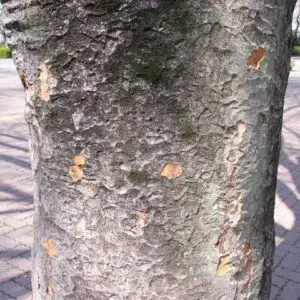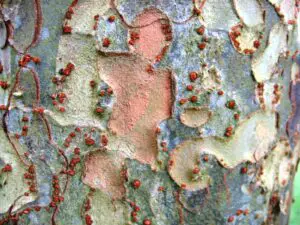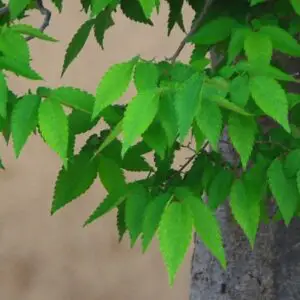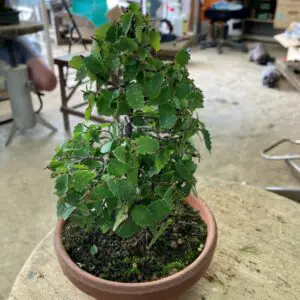Specifics About Elm Trees
Elm trees
Elm trees are a diverse group of deciduous trees that belong to the genus Ulmus in the Ulmaceae family (elm family). These include species like American elm, Chinese elm, and European elm.
Japanese Zelkova is botanically distinct from other elms though there are resemblances to other elm trees in leaf shape and growth habits. Japanese Zelkova, while sometimes referred to as “Japanese elm”, is not in the Ulmus genus, though it is in the elm family (Ulmaceae family). It belongs to a separate genus called Zelkova.
Japanese zelkova
Description
Japanese zelkova (Zelkova Serrata), also known as Keyaki, is a species of the genus Zelkova native to Eastern Asia, specifically Japan, Korea, eastern China and Taiwan. It is a medium-sized deciduous tree usually growing to 20-25 m (65-80 ft) tall.
The branches grow outward in a fan-like pattern, giving the tree a distinctive and visually appealing shape.
Leaf

Japanese zelkova leaf: serrated margins have curvatures
The leaves of Japanese zelkova are arranged alternately along the branches. They are generally 1 to 4 inches (3 to 10 cm) long, with an ovate shape. The serrations along the leaf margins have a unique curvature, pointing towards the leaf tip, which is sharply pointed.
Bark

Japanese elm bark
The color of the Japanese zelkova bark is grayish like grayish-white or grayish-brown. In younger trees, the bark is smooth and marked by oblong grains. As the tree ages, the bark undergoes a transformation. It begins to peel off in a mosaic or scale-like pattern, resulting in a mottled appearance on the trunk’s surface.
Common names
Japanese Zelkova, scientifically known as Zelkova Serrata, is an elm family tree. Japanese Zelkova is commonly referred to as “Keyaki”, which literally is the translation of “Japanese zelkova” in Japanese. It is also called “Japanese elm,” or simply “Zelkova.”
The term “elm” is sometimes added to its name because of its resemblance to other elm trees, both in leaf shape and growth habit. While this common name might suggest a direct relation to true elms, Japanese Zelkova belongs to the Ulmaceae family but is a distinct genus.
Chinese elm
Chinese elm (Ulmus parvifolia) is a species of the genus Ulmus native to eastern Asia, including China, India, Japan, Korea, and Vietnam. It is a small to medium-sized deciduous tree growing to 33–59 ft (10–18 m) tall.
Leaf

Chinese elm leaf
Leaves of Chinese elms are relatively small compared to other elm trees, about 1 to 2 inches long. They are elongated oval-shaped, with very short tips. Along the edges of these leaves, one can observe a finely serrated or toothed pattern.
Bark

Chinese elm bark
As the Chinese elm matures, its bark develops interesting patterns: a combination of spotted or marbled areas with different shades of gray, orange and brown.
American elm
American elm (Ulmus americana) is a species of the genus Ulmus native to eastern North America. It is a medium-sized deciduous tree growing to more than 100 feet (30 m) tall.
Leaf

American elm leaf
The leaves of the American elm are alternate, 3 to 8 inches (7 to 20 cm) long, with double-serrate margins that feature a large tooth with small teeth-like edges on top.
Bark

American elm bark
(Source: SriMesh)
When mature, the bark of the American elm is grayish-brown with deep, irregular furrows and prominent ridges, creating a rugged and textured appearance on mature trees.
Elm Tree Identification
Japanese zelkova
Japanese elm has distinct characteristics that set it apart from other tree species.

Japanese elm leaf

Japanese elm bark
To identify Japanese Zelkova:
- Examine the leaves: Look for ovate leaves with very serrated margins and a vibrant green color during the growing season.
- Observe the bark: Japanese elm’s smooth, grayish-brown, paperly exfoliating bark is a distinguishing feature.
Chinese elm
Chinese Elm shares some similarities with other elm species but has its unique features.

Chinese elm leaf

Chinese elm bark
To identify Chinese Elm:
- Observe the leaf: Leaves are finely serrated and narrower oval in shape with very short tips.
- Examine the bark: The bark is spotted with orange-brown patches.
American elm
The American Elm is a classic tree known for its unique leaves and bark.

American elm leaf

American elm bark
(Source: SriMesh)
To identify American Elm:
- Focus on leaf shape: Look for oval leaves with double-serrated margins and a deep green color.
- Observe the bark: The bark is brown and rough with distinctive furrows and ridges.
Differences Between Elm Trees
Tree bark
The most reliable and easiest way to differentiate between Japanese, Chinese, and American elm trees is to examine their bark color and structure.
When mature, Japanese zelkova has smooth, grayish-brown, paperly exfoliating bark, while Chinese elm has spotted bark with patches of orange-brown and gray. American elm’s bark is brown and rough with distinctive furrows and ridges.
Japanese zelkova bark: smooth, grayish-brown

Japanese elm bark
Chinese elm bark: spotted with patches of orange

Chinese elm bark
Leaf shape
You can also tell the difference between Japanese, Chinese, and American elm trees by focusing on leaf shape.
- Japanese zelkova and Chinese elm leaf is generally narrower oval compared to American elm leaf which is more rounded oval.
- Both Japanese zelkova and American elm leaves have long, pointed tips, whereas the Chinese elm leaf has very short tips.
- The tip of the Japanese zelkova leaf is tapering from the mid-leaf to a long point compared to the American elm leaf whose tip is shorter and slender.
- Margins are double-serrated for American elm, while single-serrated for Japanese zelkova and Chinese elm.
Japanese zelkova leaf: narrower oval, long-pointed tip, single-serrated margin

Japanese zelkova leaf
Chinese elm leaf: narrower oval, very short tip, single-serrated margin

Chinese elm leaf
American elm leaf: rounded oval, shorter/slender tip, double-serrated margin

American elm leaf
Leaf size
Leaf size can be an indicator to tell the difference between Japanese, Chinese, and American elm trees. Assuming the trees are about the same age, the Chinese elm leaf is the smallest, followed by the Japanese zelkova leaf, and by the American elm leaf being the largest.
- Japanese zelkova: Moderate-sized leaves (1-4 inches (3-10cm)).
- Chinese elm: Smaller leaves (0.8-2 inches (2-5cm))
- American elm: Larger leaves (3-8 inches (7-20cm))
Comparison table
| Japanese zelkova | Chinese elm | American elm | |
| Latin name | Zelkova serrata | Ulmus parvifolia | Ulmus americana |
| Native to | Eastern Asia | Eastern Asia | North America |
| Leaf size | 1-4 inches (3-10cm) | 0.8-2 inches (2-5 cm) | 3-8 inches (7-20cm) |
| Leaf shape | Ovate | Ovate | Ovate |
| Leaf margin | Serrated | Serrated | Double-serrated |
| Leaf arrange | Alternate | Alternate | Alternate |
| Bark | Grayish-brown, smooth | Spotted, parches of orange | Rough, furrows |
Bonsai and Elm Trees
Choosing the Perfect Elm Tree for Bonsai
Elm trees make excellent candidates for bonsai cultivation. Here are my top choices for your elm bonsai project:
- Chinese elm
- Japanese zelkova
- American elm
Chinese elm

My Chinese elm bonsai
Chinese elm is an excellent choice for those new to bonsai due to its exceptional qualities:
- Longevity and sturdiness: Impressive longevity and sturdiness, outshining many other deciduous tree species.
- Vibrant growth: Known for its rapid growth, allowing you to witness your bonsai’s progress more quickly.
- Easy propagation: Propagate easily through cuttings, air-layering and grafting.
- Vigorous regeneration: Has robust budding capabilities and can withstand hard pruning, making it highly adaptable for bonsai shaping.
- Small leaves and fine ramification: Chinese elm’s naturally small leaves and tendency to ramify into delicate branches facilitate intricate bonsai designs.
- Seasonal beauty: Striking spring green and autumn foliage.
- Distinctive bark: An interesting bark pattern adds an intriguing element to your bonsai creations.
Japanese zelkova

My Japanese zelkova bonsai
Japanese zelkova is another popular choice for bonsai creation, which is also an excellent choice for beginners.
- Sturdiness: Sturdy and tolerates hot and cold well.
- Vibrant growth: Known for its rapid growth and vigorous regeneration, withstanding hard pruning.
- Small leaves: Leaves are naturally small.
- Fine ramification: Ramifies into delicate branches in many numbers.
- Seasonal beauty: Striking spring green, autumn foliage and fine branching without leaves in winter.
- Easy to bonsai: Relatively easy to bonsai and fit for all bonsai styles.
If you decide to grow Japanese zelkova bonsai, here’s a comprehensive guide for it.
American elm
American elm can be a good choice for bonsai but it is generally considered more challenging compared to other elm species like Chinese elm or Japanese zelkova.
One of the reasons is that its leaves are naturally larger compared to other elm species commonly used for bonsai. While it is possible to make them small with the bonsai technique, larger leaves can make achieving a balanced and aesthetically pleasing bonsai more difficult.
Also, the American elm is susceptible to Dutch Elm Disease, a fungal infection that can be devastating to the tree. Japanese zelkova is immune to this disease and is generally pest-free.
Is Chinese Elm a Beginner-Friendly Bonsai Choice?
Among elm species, the Chinese elm is a beginner-friendly bonsai and here’s why:
- Small leaves: It naturally has small leaves, which is desirable for bonsai aesthetics and easier to manage for beginners without necessarily applying bonsai techniques.
- Tolerant of pruning: Chinese elm tolerates pruning and shaping well, allowing beginners to experiment and learn without fear of deforming the tree.
- Hardiness: Chinese elm is known for its resilience and ability to thrive in various conditions, making it forgiving for novice bonsai practitioners. It can survive in USDA Hardiness Zones 4-9, generally hardy from zones 5 to 8.



